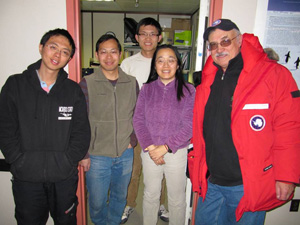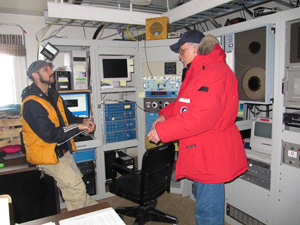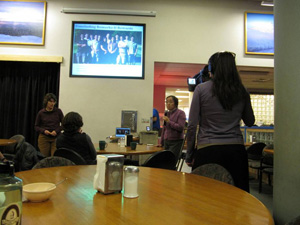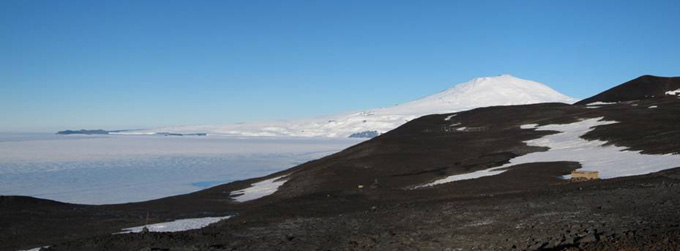After the gorgeous weather around Christmas (maximum reaching about +5C with clear sky), McMurdo had overcast sky for nearly two weeks from December 28th, 2010 to the morning of January 9th, 2011. Since the lidar beam couldn’t penetrate such thick clouds, we took this time to optimize the lidar system, provide training opportunities to our winter-over student Zhibin Yu, spend tons of time to work on the EMI issue, and do preliminary analysis on our lidar data collected so far. The 8th week was highlighted by Dr. Vladimir Papitashvili’s 2nd visit to our lidar at Arrival Heights, the science lecture I gave to the folks at McMurdo and Scott Base, the teaching of a lidar class to CU-Boulder graduate students via Skype, and a new classical story of Zhibin!
Dr. Vladimir Papitashvili from NSF visited us on his way out from the South Pole, and spent three days with us to solve the EMI issue (January 4-6, 2011). A meeting was held among major players, and a consensus was reached after we presented tons of test results. Several test results, including a Mac laptop computer’s power adaptor can generate significant EMI to the VLF experiment, and the EMI strength largely depends on which phase the power adaptor is plugged in, indicate that the Arrival Heights EMI is an issue associated with the entire power, grounding, and equipment system at Arrival Heights, not a standalone problem with the lidar. The group’s sense is that the Arrival Heights facilities and experiments have evolved over time and may contain a number of noisy power sources that transmit or conduct noise, likely exacerbated by inconsistent or poor grounding/bonds in an area that does not offer useful local earth grounds. The installation of the LIDAR, including running 3-phase 208-V power from the USAP transformer to the AntNZ Arrival Heights Facility, may have amplified existing noise and added new noise to the system. In analogy, the lidar is perhaps the last cup of water pouring into a bucket. With help from many people, especially an expert Dr. Evans Paschal from US, we are making progress together with USAP and AntNZ to resolve the EMI issue.

Vladimir with the lidar team in front of our office 116 in Crary Lab. His visit is a big support to us.

It turns out that Vladimir is quite an expert on electromagnetic theory and electrical and magnetic practice. His visit to Arrival Heights facilities did help gain a deeper understanding of the EMI problem, and now the issue is being looked at from a much larger point of view.

The new NSF Science Representative Alex was introducing me to the audience before the lecture. The talk’s cover page made by Weichun is visible from the screen.

At the end of the talk, I was answering questions from audience while an IT lady recording the lecture.

To show our appreciation to the AntNZ and USAP people, I sent two students Zhibin and Weichun to Scott Base to take photos on the people for use in the science lecture. This is Zhibin with two Scott Base Science Technicians (Nita on the left and Victoria on the right). Wasn’t he very happy?
Teaching a graduate 6000-level lidar class isn’t new to me, but through Skype from Antarctica to Colorado is definitely the first time. We did it on Tuesday morning (Jan. 11, 2010) at 9am (Colorado time 1pm on Monday afternoon 1/10/2010) from Crary Lab. This was an interesting setup as Zhibin and Weichun were with me in the Crary Library at McMurdo, and other students were in the classroom of ECCR 151 at CU-Boulder. Many thanks to the modern IT and communication technology and a big help from my student John Smith who set up equipment in ECCR 151 and a Crary staff Annette who set up equipment in Crary. John set up a very nice webcam so that we could see students in Colorado quite well. But the built-in camera on my Mac doesn’t have high resolution, so the live video from Antarctica wasn’t clear enough. Nevertheless, with my powerpoint presentation sent to students prior to the class, the lecture went well. We have now got a better webcam at McMurdo so we will try again the Skype lidar teaching before I head back to US by the end of next week.
With Wentao Huang’s big help, we were able to put three panorama pictures together to show the nice scenes surrounding Arrival Heights. These three shots were taken during the Christmas nice weather.
So far I have been positive about the food at McMurdo in my journey reports, especially the Christmas dinner was just fantastic. Unfortunately, the food quality began to decrease since the New Year’s eve. First we had hot dogs on the new year’s eve, and then the food got worse and worse, except a few occasions of good food. In the last a few days, the food tasted so bad that I had a hard time finding suitable things to eat. Now I feel the cereal is actually a better choice. By Tuesday noon, I was so hungry but not sure how I could feed myself as the lunch was just terrible. Suddenly, sitting beside me, Zhibin said one sentence which became a classic — “我正用我的丹田之气把食物咽下去!” (“气运丹田,下咽食物”). Translation into English? He says that he has to use Chinese Kong Fu to swallow the food! In other words, he is forcing himself to get the food into his body in order to gain enough energy. What an accurate account — exactly my feeling at that moment! With this spirit, I believe Zhibin will survive the winter for sure!
Finally, our preliminary analysis has shown exciting results from the lidar data taken in December at McMurdo, not only on the Fe layers, but also on the polar mesospheric clouds (PMCs). We had a “bet” in early December to guess the initial PMC altitudes. Now the first PMC signals have been obtained, and I’m going to announce the winner once Chet arrives in McMurdo on this coming Saturday.
Have a wonderful spring semester!
Sincerely,
Xinzhao





